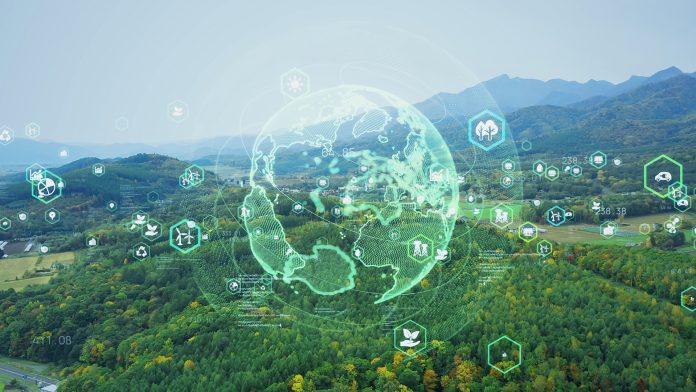Jai Thattil, Head of Strategic Marketing at Juniper Networks, outlines the importance of prioritising sustainable networking as the demand for connectivity grows.
Across the entire tech sector, sustainability is a buzzword right now. Earth Day 2023 brought back into focus the importance of having a keen eye on our working practices and ensuring that they are set to do the best for our planet. With the emphasis this year being on ‘Invest in Your Planet,’ it’s reared the discussion of what businesses can do today to ensure they are investing in the future of the planet and the sustainable working practices of the future.
Every vertical needs to take its own responsibility, and some more than others have a spotlight impact. For example, the travel and manufacturing industries are always top of the list in sustainability talks because they have tangible issues regarding environmentally friendly practices.
There are plenty of steps that businesses are taking to become greener. However, little consideration is given to the sustainable practices in networking, and how making small changes to a networking operation could have a significant environmental impact.
This is mainly due to the fact that the output isn’t tangible.
It takes a little lateral thinking to consider the environmental impact of networking and its sustainable practices, but it is a conversation that we need to be having – and having now.
Effectively collaborate to connect reliably
When it comes to connectivity in our community, it’s undisputed that there is a need for reliable connectivity in urban areas. For some time now, our entire lives have relied on having good connectivity and the ability to connect to anything, anywhere. The advent of hybrid working saw the need for good connectivity grows further still, now not only operating our personal lives from anywhere but our professional lives too.
What’s becoming apparent is the need to balance this widespread connectivity with sustainability – providing always-on, reliable connections, but in a green and environmentally friendly fashion.
Sustainability is vital for several reasons, whether for the betterment of our planet, creating a more in-tune customer outlook, or future-proofing operations against new environmental legislations.
A key component to delivering sustainable networking is collaboration.
We live in a world where gaining the upper hand over competitors is everything, but rather than working as individual companies, service providers should implement common practice initiatives through which established operators can aid others in reducing their emissions targets.
Because there is so much pressure on individual companies to meet targets set by customers and regulators, operators may feel like they are in a bubble without collaboration across the industry.
However, if the sector is to reach an overall net zero, competitors must co-operate for the best possible results.
Because networks are not something consumers usually see or physically interact with, the infrastructure is often easy to overlook.
However, internet connections rely on routers, switches, hubs, repeaters, gateways, bridges, and modems, all of which are manufactured in facilities across the globe and need energy in order to work.
In fact, by 2025, the Internet is predicted to consume 20% of the world’s electricity. As internet providers look to constantly improve their network service, they must also focus on how they can provide the best possible service sustainably.
It’s only when we take a deeper look into networking that we realise what an environmental impact it can truly have.

Utilising cloud principles to remain sustainable
To optimise a business’ sustainability strategy, network operators should familiarise themselves with the basic cloud principles and utilise passive infrastructure when looking to upgrade or expand their network. This means that rather than demolishing and rebuilding an unused site, they can use existing infrastructure for new projects.
Passive infrastructure is an optimal choice rather than the rip-and-replace model, as it reduces emissions from the production of materials and the building process.
As service providers look to install a 5G network, this is particularly important as it reduces unnecessary waste. To roll out an effective network upgrade, various aspects of the infrastructure must also be reformed. If businesses are to carry out these processes sustainably, green practices must be central to actions from the planning stage until completion.
5G is an environmental challenge in itself. It requires much energy to operate, and the fact that it is a ground-breaking connectivity development ultimately means that the global demand will grow exponentially, requiring more energy to install.
Whilst 5G is the future of connectivity, and will lead the way for new network innovations, it should be recognised that there is a significant environmental implication attached to its installation. Therefore, considerations should be made as to how to mitigate these as much as possible.
Similarly, another principle that should be taken on is extending product life, which ultimately leads to unused products going to landfills and, as a result, fewer new products being produced unnecessarily. When maintenance is required, if possible, engineers should look to repair and replace parts rather than substitute the whole device.
When manufacturing new products, sustainability and longevity should be central to the design of each device. As well as working with today’s technologies, manufacturers should look to future-proof them to be compatible with innovations down the line.
New technology to aid sustainable planning
One key point for sustainability and reducing the environmental impact of operations is the use of technology. The rise of Artificial Intelligence (AI) and automation offers providers and operators an excellent opportunity to ensure that networks are functioning in the most efficient manner possible.
There are many ways that AI and automation can aid a sustainability strategy. For example, they can be used to fix faults within the network before they cause disruption and require manual intervention. If certain aspects of the network are not being used, operators can use AI to switch them off and ensure optimal performance. AI technologies can also analyse the network to ensure it works efficiently. With these tools assisting engineers by resolving network issues automatically, they can reduce unnecessary manual maintenance, which in itself produces emissions.
The importance of education for sustainable networking
As metro networks are being upgraded, operators should continue looking at ways to invest effectively in the planet and its future. From an outside perspective, this may seem like moving away from profitability, but in reality, this could not be less accurate.
End users and other companies are now looking to measure their indirect emissions, and sustainability in service providers makes them a more attractive option for customers.

Moreover, ensuring the longevity of products means that there is a better return on investment for devices that don’t need replacing. Equally, the use of passive infrastructure limits the need for expensive and complex building processes, which are often not cost-effective. Reducing inefficiencies in the network can also lead to better profits for network operators as they reduce unnecessary energy expenditure.
An additional consideration is a new legislation being introduced almost weekly surrounding sustainable and green operations, and the earlier that businesses can implement a strong strategy, the less likely they are to be caught out by new regulations.
Being ahead of the curve will allow a strategy to be more cost-effective and will also show that a business is being proactive in its sustainable infrastructure, rather than reactive. Naturally, companies who don’t anticipate legislation and act before it’s required end up paying more to rectify their operations and can often be tarnished with a negative reputation.
In a business world where reputation is everything, it’s vital that businesses do everything they can to uphold a positive image.
Educating operators, users, and consumers about the impact of sustainable networking will help to build the networking plan of tomorrow for businesses and consumers alike. Ultimately, collaboration is key, and that’s not just down to networking providers working together. If everybody works towards one unified goal of environmentally friendly operations, then the networks powering every sector can provide a more sustainable, and environmentally friendly future for a greener world.





